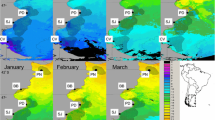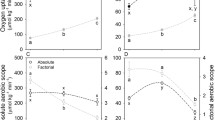Synopsis
Aerobic heat production and heat loss via the gills are inexorably linked in all water breathing teleosts except tunas. These processes are decoupled in tunas by the presence of vascular counter-current heat exchangers, and sustained (i.e., steady state) muscle temperatures may exceed water temperature by 10° C or more in larger individuals. The presence of vascular counter-current heat exchangers is not clearly advantageous in all situations, however. Mathematical models predict that tunas could overheat during strenuous activity unless the efficacy of vascular heat exchangers can be reduced, and that they may be activity limited in warmer waters. Tunas may likewise be forced out of potentially usable habitats as they grow because they have to occupy cooler waters. Vascular counter-current heat exchangers also slow rates of heating and cooling. A reduced rate of muscle temperature decrease is clearly advantageous when diving into colder water to chase prey or avoid predators. A reduced rate of heat gain from the environment would be disadvantageous, however, when fish return to the warmer surface waters. When subjected to changes in ambient temperature, tunas cannot defend a specific body temperature and do not thermoregulate in the mammalian sense. Yet when appropriately analyzed, data taken under steady state and non-steady state conditions indicate that tunas are not strictly prisoners of their own thermoconserving mechanisms. They apparently can modify overall efficiency of their vascular counter-current heat exchangers and thus avoid overheating during bouts of strenuous activity, retard cooling after diving into colder water, and rapidly warm their muscles after voluntarily entering warmer water. The exact physiological mechanisms employed remain to be elucidated.
Similar content being viewed by others
References cited
Baish, J.W. 1990. Heat transport by counter-current blood vessels in the presence of an arbitrary temperature gradient. J. Biomech. Eng. 112: 207–211.
Barkley, R.A., W.H. Neill & R.M. Gooding. 1978. Skipjack tuna, Katsuwonus pelamis, habitat based on temperature and oxygen requirements. U.S. Fish. Bull. 76: 653–662.
Barrett, I. & F.J. Hester. 1964. Body temperature of yellowfin and skipjack tunas in relation to sea surface temperature. Nature 203: 96–97.
Beitinger, T.L. & K.A. Anderson. 1979. Internal convective and conductive heat loss in the mudpuppy, Necturus maculosus. Comp. Biochem. Physiol. 62A: 1035–1039.
Beitinger, T.L. & L.C. Fitzpatrick. 1979. Physiological and ecological correlations of preferred temperature in fishes. Amer. Zool. 19: 319–329.
Beitinger, T.L., M.M. Thommes & S.A. Spigarelli. 1977. Relative roles of conduction and convection in the body temperature change of gizzard shad, Dorosoma cepedianum. Comp. Biochem. Physiol. 57A: 375–379.
Block, B.A. 1986. Structure of the brain and eye heater tissue in marlins, sailfish, and spearfishes. J. Morphol. 190: 169–189.
Block, B.A., J.R. Finnerty, A.F.R. Stewart & J. Kidd. 1993. Evolution of endothermy in fish: mapping physiological traits on a molecular phylogeny. Science 260: 210–214.
Brafield, A.E. & D.J. Solomon. 1972. Oxy-calorific equivalents for animals respiring nitrogenous substances. Comp. Biochem. Physiol. 43A: 837–841.
Brill, R.W. 1987. On the standard metabolic rate of tropical tunas, including the effect of body size and acute temperature change. U.S. Fish. Bull. 85: 25–35.
Brill, R.W. 1992. The Kewalo Research Facility, 1958–92: Over 30 years of progress. NOAA Technical Memorandum, NOAA-TM-NMFS-SWFSC-171. 41 pp.
Brill, R.W., D.L. Guernsey & E.D. Stevens. 1978. Body surface and gill heat loss in restrained skipjack tuna. pp. 261–276.In: G.D. Sharp & A.E. Dizon (ed). The Physiological Ecology ofTunas, Academic Press, New York.
Carey, F.G. 1982. A brain heater in swordfish. Science 216: 1327–1329.
Carey, F.G. & Q.H. Gibson. 1987. Blood flow in the muscle of free-swimming fish. Physiol. Zool. 60: 138–148.
Carey, F.G. & K.D. Lawson. 1973. Temperature regulation in free-swimming bluefin tuna. Comp. Biochem. Physiol. 44A: 375–392.
Carey, F.G. & J.M. Teal. 1966. Heat conservation in tuna fish muscle. Proc. Natl. Acad. Sci. U.S.A. 56: 1464–1469.
Carey, F.G. & J.M. Teal. 1969. Regulation of body temperature by the bluefin tuna. Comp. Biochem. Physiol. 28A: 205–313.
Carslaw, H.S. & J.C. Jaeger. 1950. Conduction of heat in solids. Oxford University Press, London. 510 pp.
Chen, M.M., K.R. Holmes & V. Rupinskas. 1981. Pulse-decay method for measuring the thermal conductivity of living tissues. J. Biomech. Eng. 103: 253–260.
Crawshaw, L.I. 1975. Twenty-four hour records of body temperature and activity in bluegill sunfish (Lepomis macrochirus) and brown bullheads (Ictalurus nebulosus). Comp. Biochem. Physiol. 51A: 11–14.
Cui, Z.F. & J.C. Barbenel. 1990. The influence of model parameter values on the prediction of skin surface temperature: I. Resting and surface insulation. Phys. Med. Biol. 35: 1863–1697.
Dean, J.M. 1976. Temperatures of tissues in freshwater fishes. Trans. Amer. Fish. Soc. 105: 709–711.
Dewar, H., J.B. Graham & R.W. Brill. 1993. Studies of tropical tunas swimming performance in a large water tunnel II: thermoregulation. J. Exp. Biol. (in review).
Dickson, K.A. 1988. Why are some fishes endothermic? Interspecific comparisons of aerobic and anaerobic metabolic capacities in endothermic and ectothermic scombroids. Ph.D. Dissertation, University of California, San Diego. 358 pp.
Dizon, A.E. & R.W. Brill. 1979a. Thermoregulation in tunas. Amer. Zool. 19: 249–265.
Dizon, A.E. & R.W. Brill. 1979b. Thermoregulation in yellowfin tuna, hunnus albacares. Physiol. Zool. 52: 581–593.
Dizon, A.E., R.W. Brill & H.S.H. Yuen. 1978. Correlations between environment, physiology, and activity and the effects on thermoregulation in skipjack tuna. pp. 233–259.In: G.D. Sharp & A.E. Dizon (ed). The Physiological Ecology of Tunas,Academic Press, New York.
Durkee, J.W. & P.P. Antich. 1991. Exact solutions to the multiregion time-dependent bioheat equations with transient heat sources and boundary conditions. Phys. Med. Biol. 36: 345–368.
Eskinazi, S. 1975. Fluid mechanics and thermodynamics of our environment. Academic Press, New York. 422 pp.
Fechhelm, R.G. & W.H. Neill. 1982. Predicting body core temperature in fish subjected to fluctuating ambient temperature. Physiol. Zool. 55: 229–239.
Ferretti, G., A. Veicsteinas & D.W. Rennie. 1989. Conductive and convective heat flows of exercising humans in cold water. J. Appl. Physiol. 67: 2473–2480.
Gates, D.M. 1972. Climate, man and his environment, Harper & Row, New York. 175 pp.
Godsil, H.C. & R.D. Bayers. 1944. A systematic study of the Pacific tunas. Calif. Fish. Bull. 60: 1–131.
Gooding, R.M., W.H. Neill & A.E. Dizon. 1981. Respiration rates and low-oxygen tolerance limits in skipjack tuna, Katsuwonus pelamis. U.S. Fish. Bull. 79: 31–48.
Graham, J.B. 1975. Heat exchange in the yellowfin tuna, Thunnus albacares, and skipjack tuna, Katsuwonus pelamis, and the adaptive significance of elevated body temperatures in scombroid fishes. U.S. Fish. Bull. 73: 219–229.
Graham, J.B. 1983. Heat transfer. pp. 248–279.In: P.W. Webb & D. Weihs (ed). Fish Biomechanics, Praeger, New York.
Graham, J.B. & K.A. Dickson. 1981. Physiological thermoregulation in the albacore Thunnus alalunga. Physiol. Zool. 54: 470–486.
Graham, J.B., W.R. Lowell, N.C. Lai & R.M. Laurs. 1989. O2 tension, swimming velocity, and thermal effects on the metabolic rate of the Pacific albacore Thunnus albacares. Exp. Biol. (Berl.) 48: 89–94.
Holland, K., R. Brill, R. Chang, J. Sibert & D. Fournier. 1992. Physiological and behavioral thermoregulation in bigeye tuna (Thunnus obesus). Nature 358: 410–412.
Jones, D.R. & D.J. Randall. 1978. The respiratory and circulatory systems during exercise. pp. 425–502.In: W.S. Hoar & D.J. Randall (ed.) Fish Physiology, Vol. 7, Academic Press, New York.
Kishinouye, E. 1923. Contributions to the comparative study of the so-called scombroid fishes. J. Coll. Agric. Imp. Univ. Tokyo. 8: 293–475.
Kubb, R.N., J.R. Spotila & D.R. Pendergast. 1980. Mechanisms of heat transfer and time dependent modeling of body temperatures in the largemouth bass (Micropterus salmoides). Physiol. Zool. 53: 222–239.
Lindsey, C.C. 1968. Temperatures of red and white muscle in recently caught marlin and other large tropical fish. J. Fish. Res. Board Can. 25: 1987–1991.
Matyukhin, V.A., T.V. Neshumova & Ya.V. Dementyev. 1975. Temperature of the red and white muscles of the Baikal grayling (Thymallus arcticus baicalensis) at different swimming speeds. J. Ichthyol. 12: 794–798.
Mendlowitz, W. 1948. The specific heat of human blood. Science 107: 97–98.
Mitchell, J.W. & G.E. Myers. 1968. An analytical model of the countercurrent heat exchange phenomena. Biophys. J. 8: 897–911.
Neill, W.H. & E.D. Stevens. 1974. Thermal inertia versus thermoregulation in ‘warm’ turtles and tunas. Science 184: 1008–1010.
Neill, W.H., R.K.C. Chang & A.E. Dizon. 1976. Magnitude and ecological implications of thermal inertia in skipjack tuna, Katsuwonus pelamis (Linnaeus). Env. Biol. Fish. 1: 61–80.
Perez-Martin, R.I., H.M. Gallardo, J.R. Nanga & J. Casares. 1989. Determination of thermal conductivity, specific heat, and thermal diffusivity of albacore (Thunnus alalunga). Z. Lebensm. Unters. Forsch. 189: 525–529.
Prosser, C.L. 1973. Respiratory properties of the blood. pp. 317–361.In: C.L. Prosser (ed.) Comparative Physiology, W.B.Saunders Company, Philadelphia.
Reynolds, W.W. & M.E. Casterlin. 1979. Behavioral thermoregulation and the ‘final preferendum’ paradigm. Amer. Zool. 19: 211–224.
Riggs, D.S. 1963. The mathematical approach to physiological problems. The MIT Press, Cambridge. 445 pp.
Roberts, J.L. & J.B. Graham. 1974. Swimming and body temperature of mackerel. Amer. Zool. 14: 1258.
Sharp, G.D. & W.J. Vlymen. 1978. The relationship between heat generation, conservation, and the swimming energetics of tunas. pp. 213–232.In: G.D. Sharp & A.E. Dizon (ed.) The PhysiologicalEcology of Tunas, Academic Press, New York.
Spigarelli, S.A., G.P. Romberg, W. Prepejchal & M.M. Thommes. 1974. Body temperature characteristics of fish at a thermal discharge on Lake Michigan. pp. 119–132. In: J.W. Gibbons & R.R. Sharitz (ed.) Thermal Ecology, Atomic Energy Commission (CONF 730505).
Spigarelli, S.A., M.M. Thommes & T.L. Beitinger. 1977. The influence of body weight on heating and cooling of selected lake Michigan fishes. Comp. Biochem. Physiol. 56A: 51–57.
Stauffer, J.R., K.L. Dickson, A.G. Heath, G.W. Lane & J. Cairns. 1975. Body temperature change of bluegill sunfish subjected to thermal shock. Prog. Fish-Cult. 37: 90–93.
Stevens, E.D. 1978. A historical introduction to the study of warm-bodied tuna. pp. 316–359.In: G.D. Sharp & A.E. Dizon (ed.) The Physiological Ecology of Tunas, Academic Press,New York.
Stevens, E.D. & F.E.J. Fry. 1971. Brain and muscle temperatures in ocean caught and captive skipjack tuna. Comp. Biochem. Physiol. 38A: 203–211.
Stevens, E.D. & F.E.J. Fry. 1974. Heat transfer and body temperature in non-thermoregulatory teleosts. Can. J. Zool. 52: 1137–1143.
Stevens, E.D. & W.H. Neill. 1978. Body temperature relations of tunas, especially skipjack. pp. 316–359.In: W.S. Hoar & D.J. Randall (ed.) Fish Physiology, Vol. 7, Academic Press, New York.
Stevens, E.D. & A.M. Sutterlin. 1976. Heat transfer between fish and ambient water. J. exp. Biol. 65: 131–145.
Stevens, E.D., H.M. Lam & J. Kendall. 1974. Vascular anatomy of the counter-current heat exchanger of skipjack tuna. J. exp. Biol. 61: 145–153.
Strunk, T.H. 1971. Heat loss for a Newtonian animal. J. Theor. Biol. 33: 35–61.
Strunk, T.H. 1973. Perspectives on linear heat transfer. Science 181: 184–185.
Sund, P. M. Blackburn & F. Williams. 1981. Tunas and their environment in the Pacific Ocean: a review. Oceanogr. Mar. Biol. Ann. Rev. 19: 443–512.
Vogel, S. 1981. Life in moving fluids. Willard Grant Press, Boston. 225 pp.
Weller, D.E., D.J. Anderson, D.L. DeaAngelis & C.C. Coutant. 1984. Rates of heat exchange in large mouth bass: experiment and model. Physiol. Zool. 57: 412–427.
Author information
Authors and Affiliations
Additional information
Paper from the International Union of Biological Societies symposium ‘The biology of tunas and billfishes: an examination of life on the knife edge’, organized by Richard W. Brill and Kim N. Holland.
Rights and permissions
About this article
Cite this article
Brill, R.W., Dewar, H. & Graham, J.B. Basic concepts relevant to heat transfer in fishes, and their use in measuring the physiological thermoregulatory abilities of tunas. Environ Biol Fish 40, 109–124 (1994). https://doi.org/10.1007/BF00002538
Received:
Accepted:
Issue Date:
DOI: https://doi.org/10.1007/BF00002538




